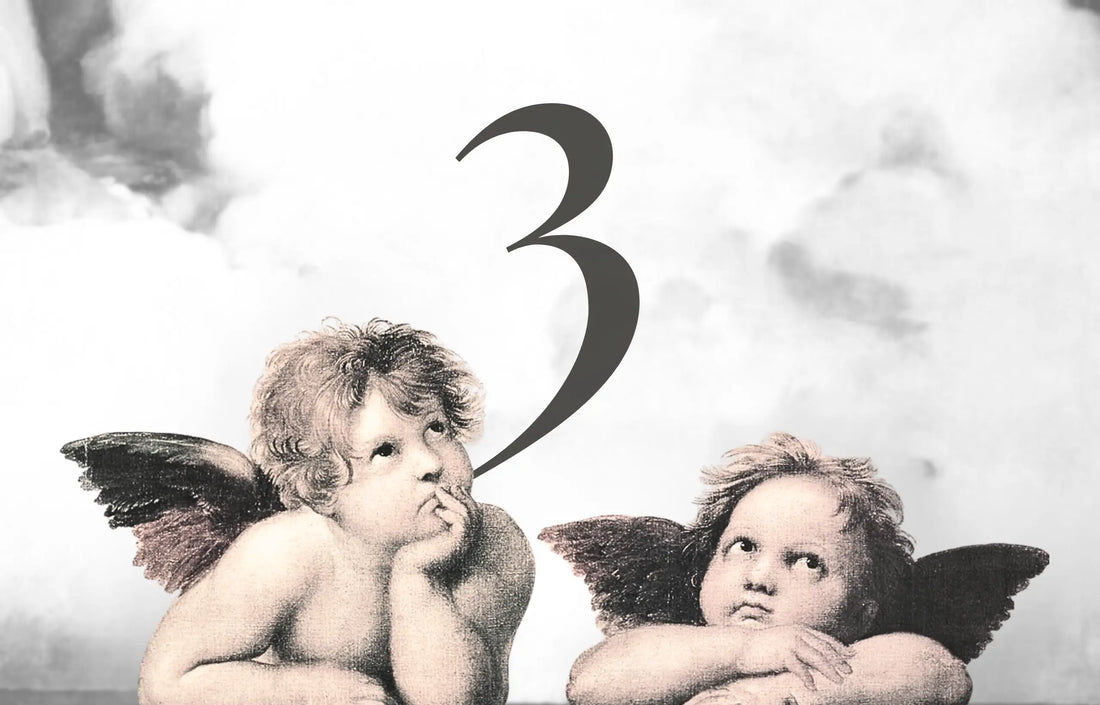Three days in a tomb. Three denials by Peter. Three persons in the Godhead—why does the number 3 shape the Bible’s most pivotal moments? Number 3 appears over 467 times in the Bible, symbolizing divine completeness and spiritual significance. Patterns of three, from the patriarchs (Abraham, Isaac, Jacob) to the angelic cry of “Holy, Holy, Holy” (Isaiah 6:3), reflect God's intentional design woven throughout Scripture.
Why the Number 3 Matters in the Bible
Symbolism Beyond Counting
In both Hebrew and Christian thought, the number 3 goes far beyond arithmetic. It signifies divine fullness, covenantal assurance, and spiritual balance—often representing God’s ideal order. It stands in contrast to 6, the number of human brokenness (think 666, Revelation 13:18).
Biblical numbers often function as theological shorthand, encoding divine truths in patterns and repetition. Early Church Fathers like Augustine recognized this. In City of God, he wrote that God created all things with “measure, number, and weight” (Book XI, Ch. 30)—a reminder that numbers aren’t filler, but signs pointing beyond the material.
Three in Hebrew and Greek Thought
In Hebrew, the word sheloshah (שְׁלֹשָׁה) suggests structure, harmony, and stability—traits reflected in biblical triads. The repetition of “Holy, holy, holy” (Isaiah 6:3; Revelation 4:8) isn’t just poetic—it underscores the unmatched holiness of God in a linguistic pattern typical of Hebrew emphasis.
The Greek New Testament carries this rhythm forward. Major turning points often unfold in threes: Jesus rises on the third day (1 Corinthians 15:4), prays three times before His arrest (Matthew 26:44), and Peter’s triple denial (and later, triple affirmation) marks a full cycle of failure and restoration. In both languages, the number 3 acts as a narrative exclamation point—a signal that something spiritually complete is taking place.
The Symbolism of the Number 3
Divine Completeness and Wholeness
Moments that unfold in threes often reveal a divine rhythm—trial, fulfillment, and completion. From Jesus praying three times in Gethsemane (Matthew 26:44) to Peter’s threefold denial and restoration, the pattern reflects spiritual progression under God's sovereign design.
These triadic events don't happen by chance—they mirror God’s timing and purpose. In Scripture, 3 becomes shorthand for a complete spiritual cycle that ends in renewal and resolution.
The Trinity: One God in Three Persons
No number carries more theological weight than 3, as it represents the Trinity: Father, Son, and Holy Spirit. This triune nature is foundational to Christian doctrine, affirming both unity and distinction within God’s being. Key passages illustrate this:
- Father: “For there is one God, the Father…” (1 Corinthians 8:6)
- Son: “In Christ all the fullness of the Deity lives in bodily form” (Colossians 2:9)
- Holy Spirit: “Now the Lord is the Spirit...” (2 Corinthians 3:17)
Together, they embody divine harmony, co-equal and co-eternal—a perfect threefold relationship of love and unity.
The Third Day: Deliverance and New Life
Throughout Scripture, the third day marks a turning point—a divine moment of transformation. Jonah emerged from the fish after three days (Jonah 1:17), and Esther approached the king after fasting three days (Esther 5:1), both signifying deliverance and divine favor.
At the center of Christian faith is the resurrection of Jesus on the third day (1 Corinthians 15:4)—a triumph over death that fulfills prophecy and offers believers new life. In every instance, the “third day” marks God’s chosen moment to intervene, restore, and reveal His power.
Triplets in Worship, Judgment, and Prophecy
The Bible often uses groups of three to emphasize spiritual depth and divine intent. Jesus faces three temptations in the wilderness (Matthew 4:1–11), revealing His victory over sin and His readiness to redeem. The patriarchal trio—Abraham, Isaac, and Jacob—stands as the foundation of God’s covenant with Israel (Matthew 22:32).
In Revelation, triads continue with three angelic proclamations (Revelation 14:6–12) and three woes of judgment (Revelation 8:13), underscoring God’s sovereignty in both mercy and justice.
How the Number 3 Shapes Biblical Story and Structure
The number 3 appears frequently throughout the Bible, shaping both grand stories and detailed literary design. In the King James Version, “three” shows up 485 times across 426 verses—mostly in the Old Testament, with significant appearances in Genesis, Numbers, 1 Chronicles, and Revelation. It ranks just behind 7 as a key spiritual number.
Old Testament Examples of 3
Before the Flood, God’s favor is seen in patriarchs Abel, Enoch, and Noah. Afterward, His covenant unfolds through Abraham, Isaac, and Jacob, the foundational fathers of Israel (Matthew 22:32). Israel’s worship rhythm also pivots around three major pilgrimage festivals—Passover, Pentecost, and Tabernacles—each reflecting God’s provision, covenant, and presence (Leviticus 23).
New Testament Examples of 3
The power of three continues with Peter’s three denials and later three affirmations of love (Matthew 26:69-75; John 21:15-17), signaling repentance and restoration. At the Transfiguration, Jesus reveals His glory to just three disciples—Peter, James, and John (Matthew 17:1-9)—highlighting intimacy and revelation.
The crucifixion narrative features a triad of times: Jesus is nailed to the cross at the third hour (about 9 a.m.), darkness covers the land for three hours, and He dies at the ninth hour (Mark 15:25-33). These timings emphasize God’s sovereign hand over salvation history.
What the Number 3 Reveals About God
The number 3 reveals profound truths about God’s nature and His interaction with humanity. Revelation calls God “the one who is, who was, and who is to come” (Revelation 1:4), a threefold expression of divine eternity and sovereignty that echoes the triune Godhead—Father, Son, and Holy Spirit—whose perfect unity transcends human understanding.
Three as a Time of Spiritual Testing
Three also marks periods of spiritual testing and validation. Jesus’ three temptations in the wilderness (Matthew 4:1-11) display His readiness for ministry, while His three days in the tomb (1 Corinthians 15:4) signify victory over death. In apocalyptic texts, sets of three judgments warn of God’s righteous justice.
Three and Covenant
Finally, the covenants with Abraham, Isaac, and Jacob form a triadic foundation pointing toward spiritual completeness fulfilled in Christ (Galatians 3:29). This triune symbolism invites believers into a relationship of wholeness and redemption.
Curious Biblical Facts about 3
Literary and Numerical Facts
The Bible has a few quirky nods to the number 3 beyond theology. For example, there are three books with exactly three chapters: Joel, Titus, and Nahum. This small detail echoes the theme of completeness tied to the number.
Interestingly, only three words appear just once in the entire Bible: “reverend” (Psalm 111:9), “eternity” (Isaiah 57:15), and “grandmother” (2 Timothy 1:5). These unique occurrences highlight how some terms carry singular, significant weight in Scripture.
Apocalyptic Symbolism
The number 3 also dominates apocalyptic imagery. Revelation introduces three angels delivering crucial messages (Revelation 14:6-12), three woes pronounced over the earth (Revelation 8:13), and three unclean spirits resembling frogs emerging from the dragon, beast, and false prophet (Revelation 16:13-14).
Even the New Jerusalem, the heavenly city, has a square shape with three gates on each side (Revelation 21:13), reinforcing the number’s role in divine order and perfection.
Lessons Christians Can Learn from the Number 3
The number 3 highlights God’s design for completeness, divine presence, and spiritual wholeness. Its repeated patterns in Scripture aren’t random—they call us to recognize God’s intentional work in history and in our lives.
Don’t fall into superstition or numerology. Instead, let the number 3 deepen your understanding of who God is—Father, Son, and Holy Spirit—and how He relates to us.
Think of the Trinity like a divine dance of love—three persons, fully united yet distinct, eternally giving and receiving love within God’s own being. Because of this perfect relationship, God doesn’t need us; He created us out of pure love, not necessity.














